Atelognathus is a genus of frogs in the family Batrachylidae. Sometimes known as Patagonia frogs, these frogs are endemic to Patagonia.

Conraua, known as slippery frogs or giant frogs is a genus of large frogs from sub-Saharan Africa. Conraua is the only genus in the family Conrauidae. Alternatively, it may be placed in the family Petropedetidae.
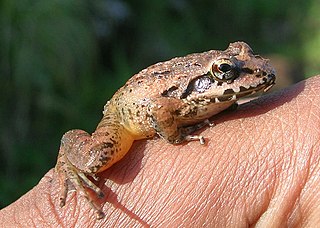
Indirana is a genus of frogs in the family Ranixalidae. These frogs are endemic to the Western Ghats of India. They are sometimes known under the common name Indian frogs, whereas members of their parent family are named "leaping frogs".
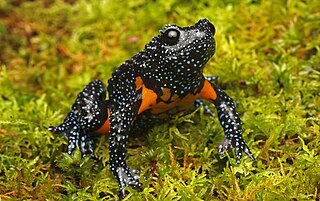
Melanobatrachus is a genus of narrow-mouthed frogs in the family Microhylidae. It is the only remaining genus in the monotypic subfamily Melanobatrachinae. It contains a single species, Melanobatrachus indicus, also known as the Indian black microhylid frog and Malabar black narrow-mouthed frog. It is endemic to wet evergreen forests of southern Western Ghats in Kerala and Tamil Nadu states of India. It has been recorded from Anaimalai, Munnar, Palni hills, Periyar Tiger Reserve and Kalakkad Mundanthurai Tiger Reserve
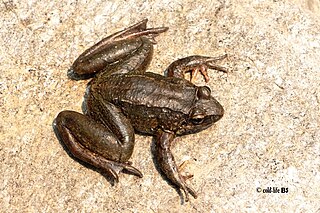
Ombrana is a monotypic genus of frogs in the family Dicroglossidae. It is represented by a single species, Ombrana sikimensis. The validity of this genus is currently considered uncertain.

Chaperina is a genus of frogs in the family Microhylidae. It is the only genus in the subfamily Chaperininae. It is also itself monotypic, being represented by the single species, Chaperina fusca, commonly known as the brown thorny frog, spiny-heeled froglet, and saffron-bellied frog. It is found on the Malay Peninsula, in Borneo and in the Philippines. It is abundant in Borneo but uncommon on the Malay Peninsula and patchily distributed in the Philippines.
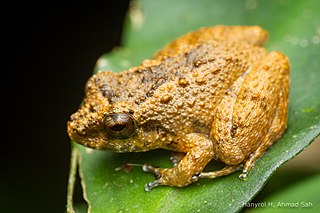
Alcalus baluensis is a species of frog in the family Ceratobatrachidae. It is endemic to northern and western Borneo. Its common name is Balu eastern frog or dwarf mountain frog. It was placed in the family Dicroglossidae before being transferred to Ceratobatrachidae in 2015.
Ingerana reticulata is a species of frog in the family Dicroglossidae. As presently known, it is endemic to Mêdog County in southeastern Tibet, China, but its range might extend to northeast India, given the proximity of the border. Common names reticulate eastern frog, reticulate wrinkled ground frog, and reticulated papillae-tongued frog have been coined for it.

Smith's wrinkled frog, commonly known as Tasan eastern frog, Tasan frog, or Tha san frog,) is a species of frog in the family Dicroglossidae. It is found in western and southern Thailand; its range likely extends to Myanmar but it has not yet been recorded there. Its natural habitats are primary rainforests near streams. It is threatened by habitat loss.

Ingerana tenasserimensis is a species of frog in the family Dicroglossidae. It is found in Myanmar, western and peninsular Thailand, and adjacent Peninsular Malaysia.

Lankanectes corrugatus is a species of frog in the family Nyctibatrachidae. It was once monotypic within the genus Lankanectes, until the second species - Lankanectes pera was described in 2018 from Knuckles Mountain Range. It is endemic to Sri Lanka.

Allopaa hazarensis is a species of frogs in the family Dicroglossidae. It is found in Hazara, Pakistan and in Kashmir in India and Pakistan. Its natural habitats are fast-flowing streams where it can occur both in torrential sections and in pools. Tadpoles use their oral disc as a sucker to hold on stones. Prolonged drought periods are a potential threat to this species.
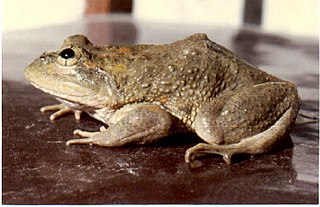
Chrysopaa is a genus of frogs in the family Dicroglossidae. It is monotypic, being represented by the single species, Chrysopaa sternosignata. It is found in Balochistan, Pakistan, Kashmir and in Afghanistan. Its common names include Baluch Mountain frog, karez frog, Malir paa frog, and Murray's frog.
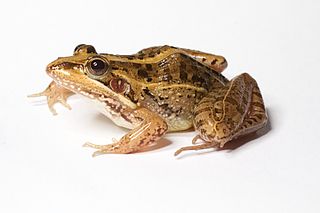
Ptychadenidae is a family of frogs commonly known as the grassland frogs. These frogs occur in Sub-Saharan Africa.
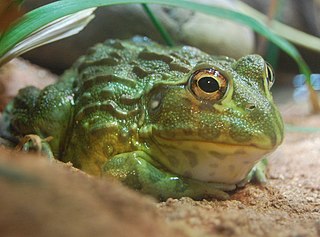
The Pyxicephalidae are a family of frogs currently found in sub-Saharan Africa. However, in the Eocene, the taxon Thaumastosaurus lived in Europe.

The frog family Dicroglossidae occurs in tropical and subtropical regions of Asia and Africa, with most genera and species being found in Asia. The common name of the family is fork-tongued frogs.

Craugastoridae, commonly known as fleshbelly frogs, is a family of New World direct-developing frogs. As delineated here, following the Amphibian Species of the World, it contains 129 species. They are found from the southern United States southwards to Central and South America.
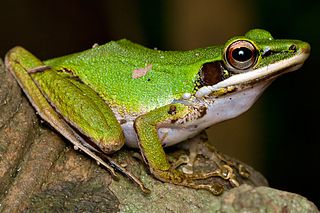
Chalcorana is a genus of frogs in the family Ranidae, "true frogs". They are found in Southeast Asia, from Thailand to Malay Peninsula and the Sunda Islands.

Quasipaa is a genus of frogs in the family Dicroglossidae. The genus has no established common name, but many individual species are referred to as spiny frogs. They occur in East and Southeast Asia, from Thailand and Cambodia to southern and eastern China.

Allopaa is a small genus of frogs in the family Dicroglossidae. Their distribution is restricted to Kashmir region of India and Pakistan. The phylogenetic placement of this genus has not been addressed with molecular methods and remains uncertain.
















